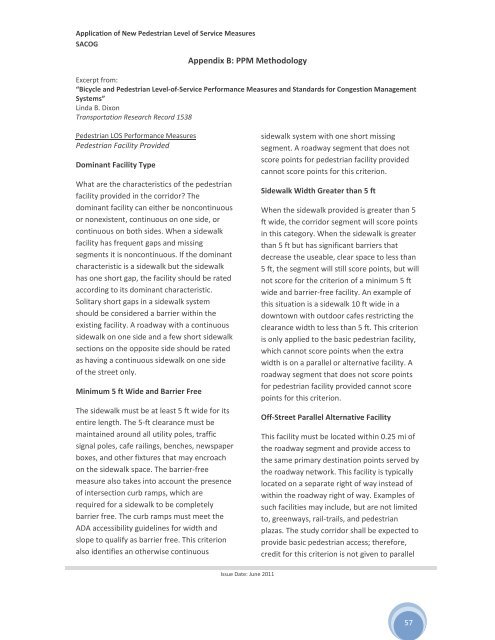Application of New Pedestrian Level of Service Measures - sacog
Application of New Pedestrian Level of Service Measures - sacog
Application of New Pedestrian Level of Service Measures - sacog
Create successful ePaper yourself
Turn your PDF publications into a flip-book with our unique Google optimized e-Paper software.
<strong>Application</strong> <strong>of</strong> <strong>New</strong> <strong>Pedestrian</strong> <strong>Level</strong> <strong>of</strong> <strong>Service</strong> <strong>Measures</strong><br />
SACOG<br />
Appendix B: PPM Methodology<br />
Excerpt from:<br />
“Bicycle and <strong>Pedestrian</strong> <strong>Level</strong>‐<strong>of</strong>‐<strong>Service</strong> Performance <strong>Measures</strong> and Standards for Congestion Management<br />
Systems”<br />
Linda B. Dixon<br />
Transportation Research Record 1538<br />
<strong>Pedestrian</strong> LOS Performance <strong>Measures</strong><br />
<strong>Pedestrian</strong> Facility Provided<br />
Dominant Facility Type<br />
What are the characteristics <strong>of</strong> the pedestrian<br />
facility provided in the corridor? The<br />
dominant facility can either be noncontinuous<br />
or nonexistent, continuous on one side, or<br />
continuous on both sides. When a sidewalk<br />
facility has frequent gaps and missing<br />
segments it is noncontinuous. If the dominant<br />
characteristic is a sidewalk but the sidewalk<br />
has one short gap, the facility should be rated<br />
according to its dominant characteristic.<br />
Solitary short gaps in a sidewalk system<br />
should be considered a barrier within the<br />
existing facility. A roadway with a continuous<br />
sidewalk on one side and a few short sidewalk<br />
sections on the opposite side should be rated<br />
as having a continuous sidewalk on one side<br />
<strong>of</strong> the street only.<br />
Minimum 5 ft Wide and Barrier Free<br />
The sidewalk must be at least 5 ft wide for its<br />
entire length. The 5‐ft clearance must be<br />
maintained around all utility poles, traffic<br />
signal poles, cafe railings, benches, newspaper<br />
boxes, and other fixtures that may encroach<br />
on the sidewalk space. The barrier‐free<br />
measure also takes into account the presence<br />
<strong>of</strong> intersection curb ramps, which are<br />
required for a sidewalk to be completely<br />
barrier free. The curb ramps must meet the<br />
ADA accessibility guidelines for width and<br />
slope to qualify as barrier free. This criterion<br />
also identifies an otherwise continuous<br />
sidewalk system with one short missing<br />
segment. A roadway segment that does not<br />
score points for pedestrian facility provided<br />
cannot score points for this criterion.<br />
Sidewalk Width Greater than 5 ft<br />
When the sidewalk provided is greater than 5<br />
ft wide, the corridor segment will score points<br />
in this category. When the sidewalk is greater<br />
than 5 ft but has significant barriers that<br />
decrease the useable, clear space to less than<br />
5 ft, the segment will still score points, but will<br />
not score for the criterion <strong>of</strong> a minimum 5 ft<br />
wide and barrier‐free facility. An example <strong>of</strong><br />
this situation is a sidewalk 10 ft wide in a<br />
downtown with outdoor cafes restricting the<br />
clearance width to less than 5 ft. This criterion<br />
is only applied to the basic pedestrian facility,<br />
which cannot score points when the extra<br />
width is on a parallel or alternative facility. A<br />
roadway segment that does not score points<br />
for pedestrian facility provided cannot score<br />
points for this criterion.<br />
Off‐Street Parallel Alternative Facility<br />
This facility must be located within 0.25 mi <strong>of</strong><br />
the roadway segment and provide access to<br />
the same primary destination points served by<br />
the roadway network. This facility is typically<br />
located on a separate right <strong>of</strong> way instead <strong>of</strong><br />
within the roadway right <strong>of</strong> way. Examples <strong>of</strong><br />
such facilities may include, but are not limited<br />
to, greenways, rail‐trails, and pedestrian<br />
plazas. The study corridor shall be expected to<br />
provide basic pedestrian access; therefore,<br />
credit for this criterion is not given to parallel<br />
Issue Date: June 2011<br />
57
















